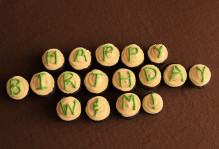Please Sir, I Want Some More… Pork Pie
“I do not pretend to teach professed cooks, but my design is to instruct the ignorant and unlearned (which will likewise be of great use in all private families) and in so plain and full a manner, that the most illiterate and ignorant person, who can but read, will know how to do every thing in cookery well.”
– Hannah Glasse, The Art of Cookery (1747), pg. 1
Hannah Glasse was an impoverished English housewife when she began to pen her widely-acclaimed cookbook. She did not intend to produce a book for the wealthy. As indicated by the straightforward text, she sought to teach servants and housewives how to cook in a manner that was simple and undemanding. The cookbook, aptly titled The Art of Cookery, Made Plain and Easy, became one of the most well-known cookbooks of the eighteenth-century.
Glasse’s popularity has resurfaced in recent years. In 2004, Prospect Books reprinted a paperback edition entitled First Catch Your Hare. In 2006, the BBC produced a thirty-minute documentary about her fame. But more pertinently to us Historic Area residents, the Department of Historic Foodways has begun to include Glasse’s recipes on their newly-created “History Is Served” blog. Not only do these entries include excerpts from The Art of Cookery, they provide twenty-first century adaptations to the recipes. We have listed some here for those ambitious chefs already preparing their Thanksgiving menus. Enjoy!
Ingredients:
- 1 lb. pork tenderloin
- 2 Tbsp. butter
- ¼ tsp. salt
- ¼ tsp. nutmeg
- 1 tsp. pepper
- 2 large Granny Smith apples
- 2 large MacIntosh apples
- 2 Tbsp. sugar
- ½ cup Rhine wine
- Pastry, homemade or store bought
Directions:
- Preheat the oven to 350°.
- Remove one piece of dough from the refrigerator and let stand until soft.
- Lightly flour your work surface and roll out dough into a 12-inch circle. Then, wrap the dough around the rolling pin to transfer into a 9-inch pie pan. Unwrap the dough from the rolling pin into the pie pan, making sure the dough is form-fitted to the pan. Allow the dough to overhang the lip of the pan. Return pie pan with dough to the refrigerator until it is needed.
- Slice the tenderloin into round slices that are ¼ inch thick. Season with salt, nutmeg, and pepper. Sear the slices in a frying pan with butter and set aside.
- Peel, core, and quarter the apples. Cut the quarters into slices that are ¼ inch thick.
- Retrieve the pie pan from the refrigerator. Fill the pie by alternating layers of pork, apples, and sugar. When the pie is filled, lay the butter over the filling. Pour in wine.
- Roll the second piece of pastry dough into a 12-inch circle. Then, wet the bottom lip of the dough and place the top piece over the filling. Trim the dough so it is flush with the edge of the pie pan. Flute the edge or press with a fork to seal. With a knife, cut 4 slits on the top of the pie.
- Place a rimmed baking sheet on the middle rack of the oven. Place the pie in the middle of the sheet. Bake at 350° for 35-45 minutes.
Ingredients:
- 2 lb. all-purpose flour
- 1 cup water
- 1 cup milk
- 2 tsp. active dry yeast
- 1 egg
- 2 tsp. salt
- ¼ lb. butter, softened to room temperature
Directions:
- Preheat the oven to 400º.
- Heat the water to 90-110º. Stir in the yeast and about half the flour. The mixture should resemble pancake batter. Set aside for 12 to 16 hours.
- The next day, your sponge should have an aroma resembling beer. Add a beaten egg to the milk and mix well. Add the milk to the sponge.
- In another bowl, mix the remaining flour, the softened butter, and salt together. Add the sponge to the remaining flour and knead for twenty minutes until the dough springs back. Add more flour a tablespoon at a time and continue kneading until the dough is no longer sticky.
- Using vegetable oil or butter, coat the entire surface of the dough to prevent a crust from forming during the rise period. Place the dough in a bowl and cover it over with plastic wrap. Set the dough to rise in a warm room for 1.5 to 2 hours or until the dough has doubled in bulk.
- One hour before you are ready to bake, punch down the dough, divide it in half, and form two tight balls. Using a knife, divide each half into eight equal pieces. Slice the ball from 12 o’clock to 6 o’clock, from 3 o’clock to 9 o’clock positions. Bisect each cut piece again, making 8 equal pieces. You should have 16 equal pieces of dough.
- Form your rolls by shaping each piece of dough into a tight compact ball. Let the finished rolls set on a baking sheet at least 3 inches apart. Cover and allow them to rise again for another 30 minutes.
- Bake the rolls for 30-35 minutes or until they sound hollow when tapped.




No comments.
Comments are currently closed. Comments are closed on all posts older than one year, and for those in our archive.